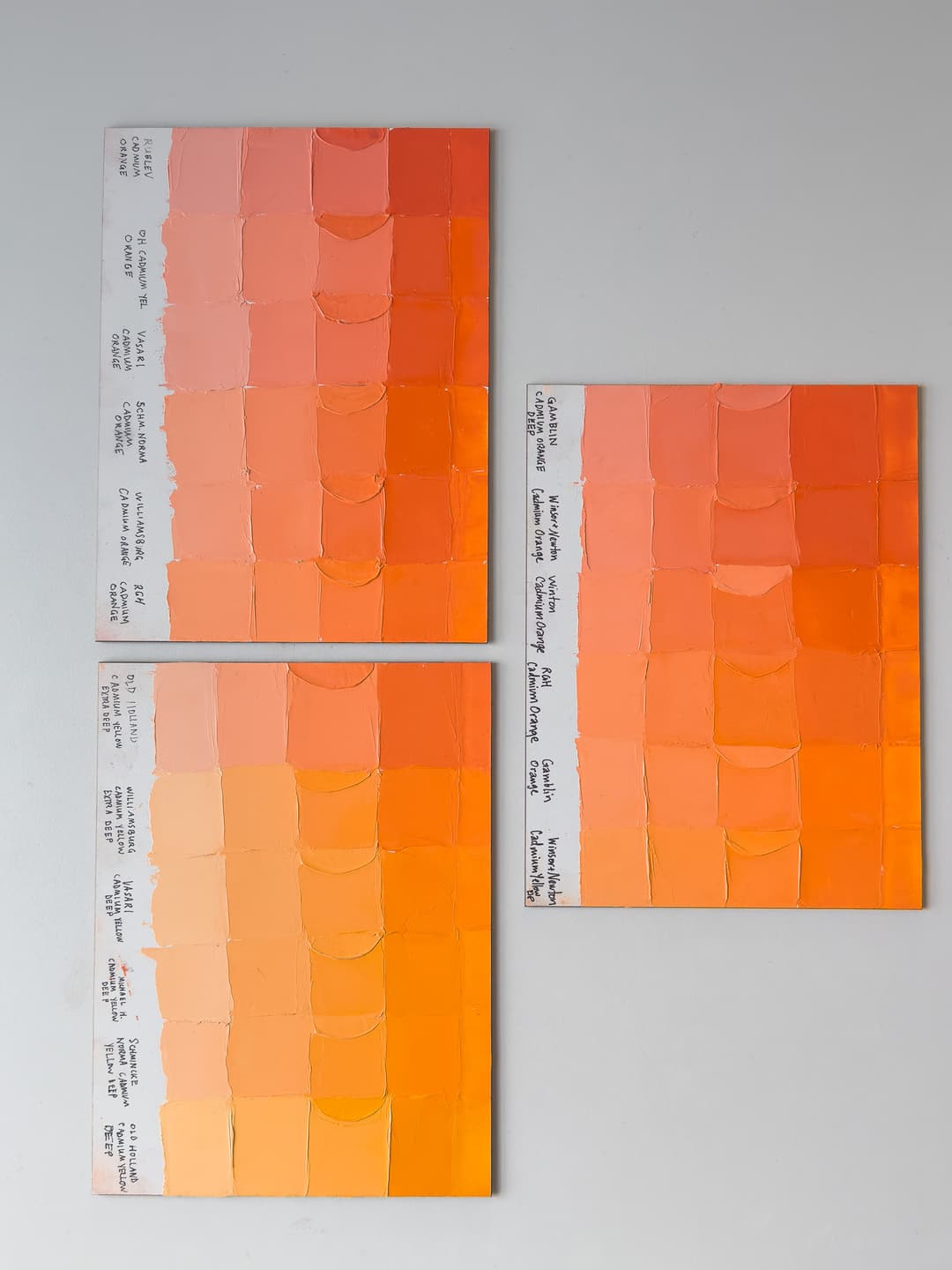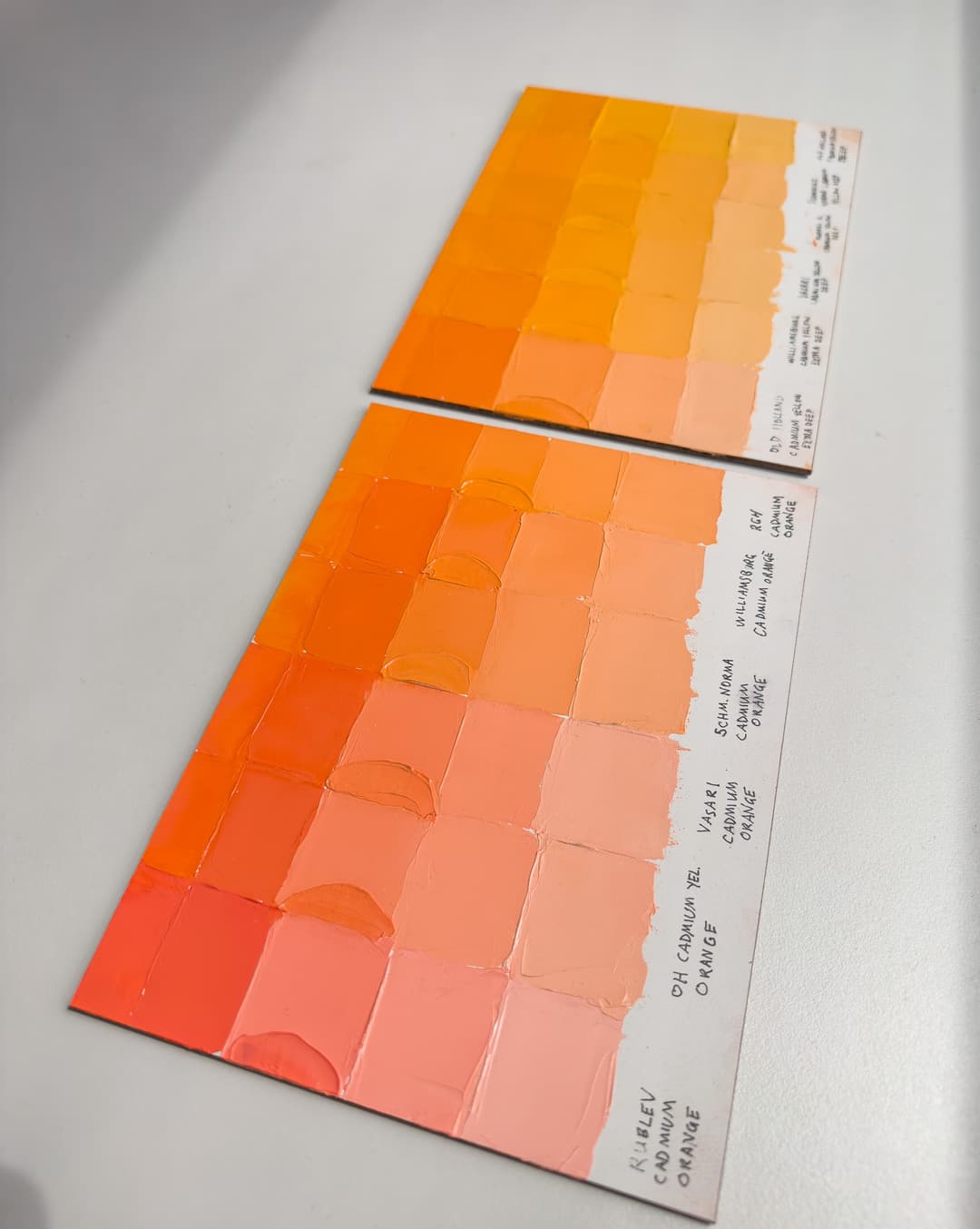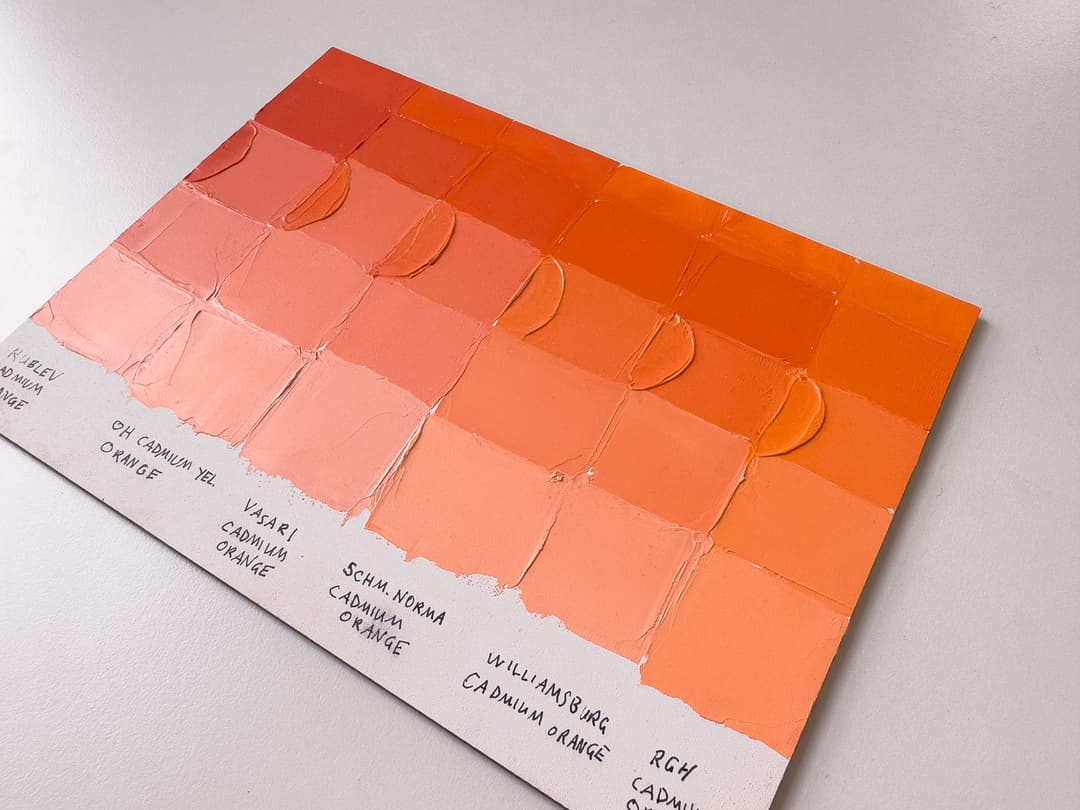A Chroma Boost in the Opaque Oranges

Cadmium Oranges Oil Paint Color Comparison and Reviews
The Must-Have Color on Your Palette You Never Knew You Were Missing
Featured Paints
The Paint Color We Never Knew We Needed
When painting with a limited palette, it seemed at first like we were saving money by mixing our own cadmium oranges without Cadmium Orange pigment, PO20. While we learned a lot about color mixing through the discipline of a 6-color-palette plus earth tones, and might recommend a strict limited palette for beginners, it took some time to realize that there was a little chroma boost that was missing. Bear in mind that for realistic painting, the chroma loss is more tolerable as many realistic subjects are muted.
However, if you want fiery red-orange, juicy middle orange, and mandarin yellow orange, that tube of PO20 is just the thing. An opaque orange with good lightfastness at a high chroma can be a rarity. Once we tried Cadmium Oranges, we wouldn’t want to paint without this arpeggio of beautiful citrus tones.

The rainbow-range of Cadmium Oranges. For context, the featured panel is on the bottom of the image. The featured panel has some fairly yellow-leaning Cadmium Oranges.
Cadmium Oranges in Premium Brands
All were strong tinters and were chosen for their super high chroma. The Rublev and the Vasari are some of the loosest paints. Vasari is oil rich, while Rublev is almost liquid in consistency- a drop of the Rublev is super high powered, which is a fun quality for this pigment. Next in order for having great glide is the Schmincke Norma. RGH was a fascinating yellow orange. Williamsburg has a soft impasto and Old Holland has a stiffer impasto, as expected.
The Cadmium Oranges tested here range from established premium offerings- Old Holland, Vasari, Williamsburg to lesser known and yet very interesting paints from RGH and Rublev. Each hue was slightly different and there were big differences in handling.

From Rublev to RGH these Cadmium Oranges Blaze with high chroma
Cadmium Oranges that Lean Yellow-Orange in Hue
Cadmium Oranges come in a wide variety of hues. These stretch toward yellow-orange (moving toward Cadmium Yellow Extra Deep).
Cadmium Orange's Debut on our Palettes
When We First Began to Notice Something Had Been Missing
It was actually through painting in gouache --that rather rare medium which shows pigment interaction so distinctively (it's weird, but true) that we first began to really notice Cadmium Orange was needed. We thought initially that a Cadmium Yellow Deep mixed with a Cadmium Red Light was sufficient for mixing high chroma oranges. However only when looking at our mix, a strangely dull tone, that reminded us of a guitar fret that is a bit off or a piano note that rings out of tune-- at first we were puzzled. The pigment quality was high, the brand was good, so what was wrong? It was only after realizing that mixing cads couldn't get us to the highest chromas in gouache that we began to see the same things in oils. So is it worth the extra cost?
You can certainly get by with a pared-down palette of reds and yellows. However if finding the brightest chromas for each paint matter to your painting practice, it can be helpful to explore a wide variety of cadmiums across brands. Each brand sources pigment from various places and chooses where to place the notes in their offering of cadmiums. It can be helpful to try lots of these to find the highest chroma paints at each hue.

The featured panel is on the top left. We keyed the values a little too high to be consistent across panels, however the hue comparisons are here for you to compare across a wide variety of brands. The bottom left panel shows Cadmium Yellow Deep hues for comparison.
The Yellower Cadmium Oranges - Still Orange
These hues edge from middle orange toward marigold
Cadmium names can be very confusing, however the pigments sort themselves somewhat into categories. In another article we reviewed a grouping of cadmium oranges that lean red, and Rublev Cadmium Orange belongs to that group. We included it here for visual comparison so that the differences can be felt. Aside from the Rublev we have roughly two groupings shown here— a middle orange group and a yellower orange category.
The Yellower Cadmium Oranges
The RGH Cadmium Orange is notably yellower than the Schmincke Norma and the Williamsburg, though all three are in the yellower orange category. We aren't sure if the RGH one is always the same hue from batch to batch- we hope so because we fell in love with this smashing color. The RGH here was yellow-orange at a super high chroma.

The variety of Cadmium Orange and Cadmium Yellow Hues
Featured Cadmium Oranges that Lean Yellow-Orange in Hue
Cadmium Oranges come in a wide variety of hues. These stretch toward yellow-orange (moving toward Cadmium Yellow Extra Deep).
Middle Cadmium Oranges and Redder Cadmium Oranges
The Redder Oranges Stretch Toward Cadmium Red Light
A few colors presented themselves as in the middle of the two groups- the redder oranges and the yellow oranges. These are the middle oranges, which on our panel would be Old Holland Cadmium Yellow Orange and Vasari. The Rublev is redder still and is included for comparison.

An array of Cadmium Oranges and a few Cadmium Red Lights with differences in hue temperature.
Featured Cadmium Oranges that a bit less yellow than the ones that lean yellow-orange. These are just the ones on the featured panel- there are a few more in other brands
Let's take a brief look at the consistency. More impasto paints would mostly be the Old Holland. Williamsburg is also impasto but it's a soft impasto. The RGH was quite soft and workable. Schmincke Norma, Vasari, and Natural Pigments are all more gliding and flowing.
Cadmium Oranges with a More Impasto Feel Right out of the Tube
The colors differed in handling. Williamsburg tends to have a softer impasto while Old Holland colors have a signature stiffness
Munsell Notes
High-Powered Chromatic Oranges
The chromas of these oranges far exceed the Munsell chips. They can be thought of in terms of red-oranges, middle oranges, and the neon tangerine by RGH.
Among these, the redder group hovers around a center closer to 1.25YR 6/14 (Rublev is redder than that), and the middle orange/yellower group centers around 2.5YR6/16. The RGH is harder to define visually with chips as it exceeds the Munsell gamut. The RGH could be a very light bright and chromatic 2.5YR or it may be closer to 5YR 7/14. The 5YR 7/16 is yellower than RGH. The RGH is oranger (a touch closer to red) and deeper than that yellow-orange chip.

An array of Cadmium Oranges that exceed Munsell chips
Cadmium Oranges that Vary in Hue
Cadmium Oranges come in a wide variety of hues and handling.
Looking for more Cadmium Oranges?
Find the single-pigment Cadmium Oranges (PO20) across brands
